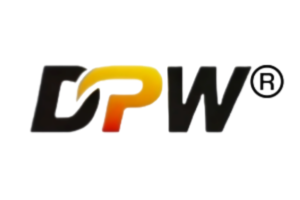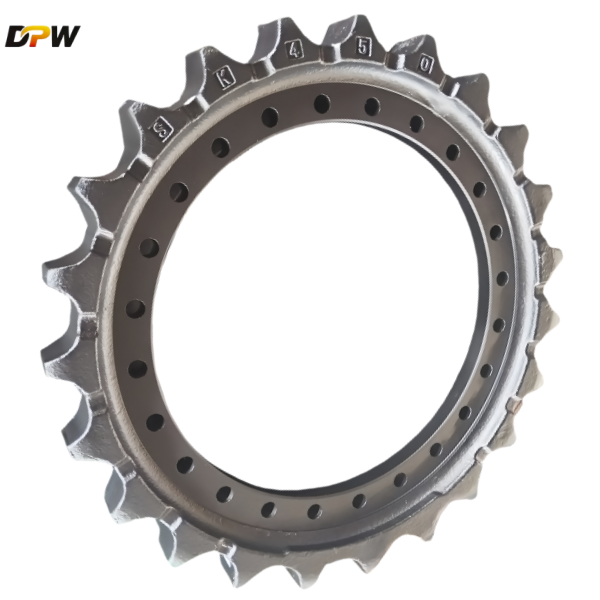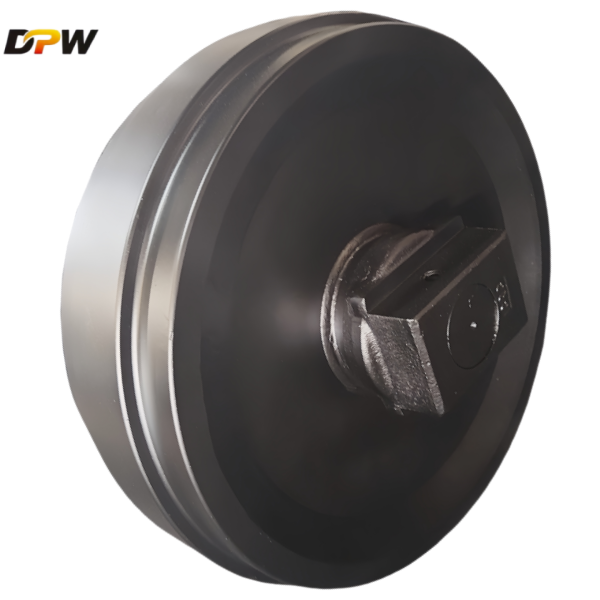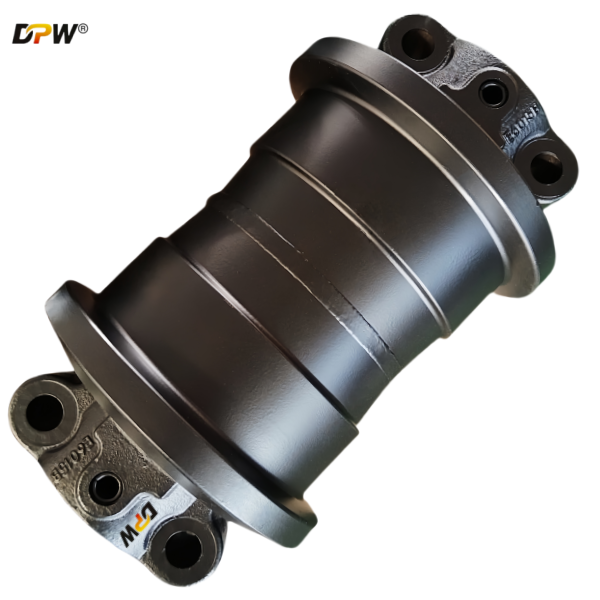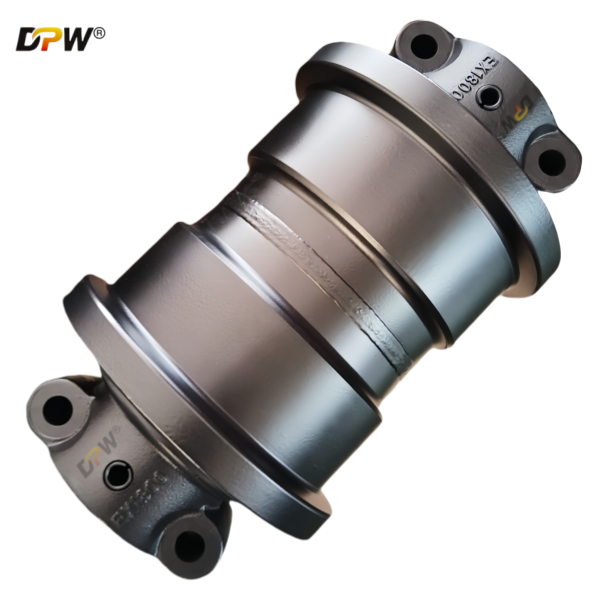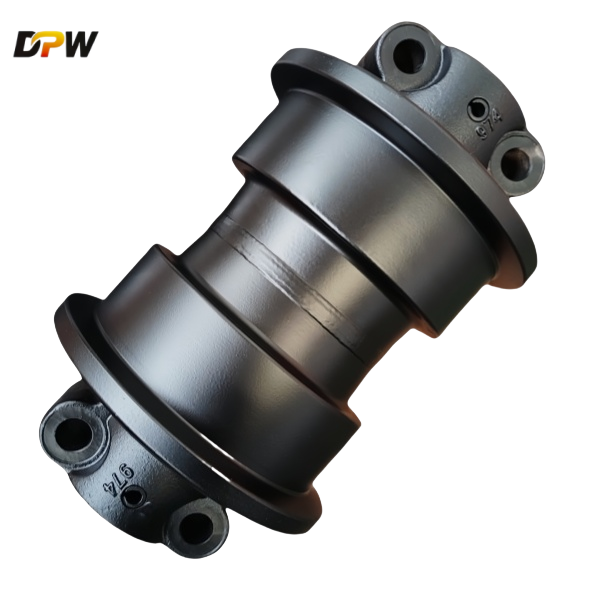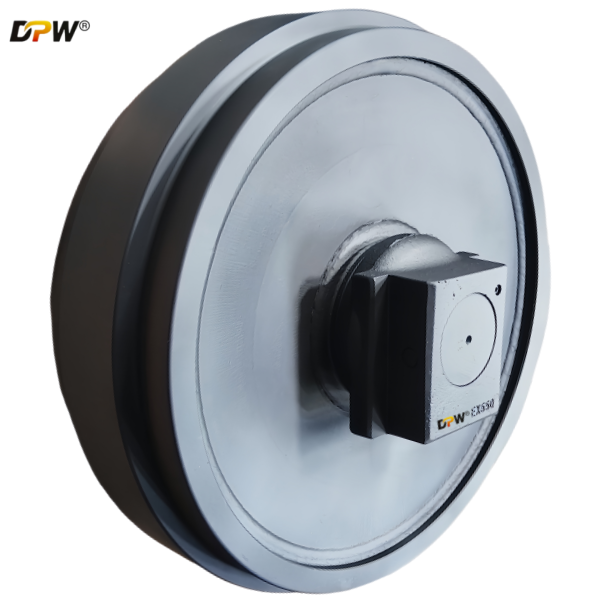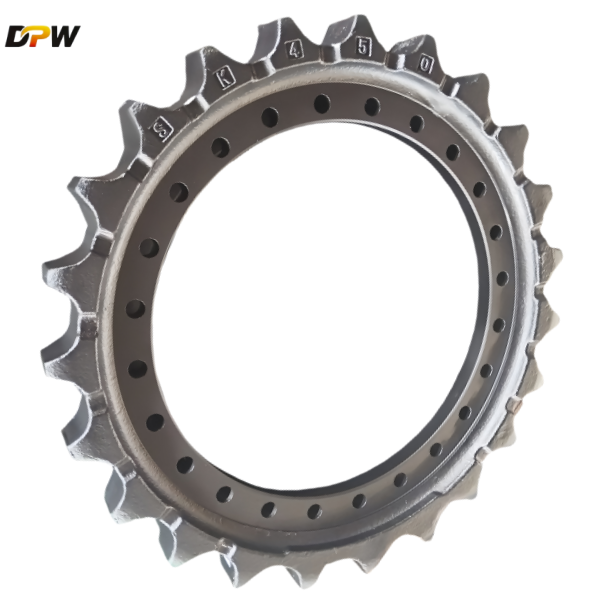
KOBELCO-SK450/SK460/SK480-Final Drive Sprocket Group/Heavy-duty Construction machinery compnent/excavator chassis system manufacture
Product Specifications
The Kobelco SK450 Final Drive Sprocket Group (often called the Sprocket & Hub Assembly or Final Drive Motor & Sprocket Assembly) is a critical and high-wear component in the undercarriage of Kobelco SK450 excavators (typically 45-50 ton class). Here's a detailed breakdown:
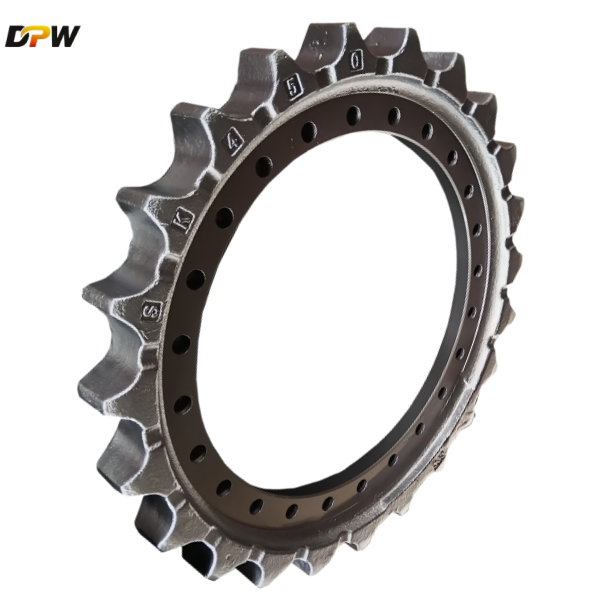
Function:
Power Transmission: Receives high torque hydraulic power from the final drive motor and transmits it directly to the track chain via the sprocket teeth.
Drive Mechanism: Engages with the track chain links/bushings to propel the machine forward or backward.
Support: Acts as the rear mounting point for the track chain assembly.
Load Bearing: Supports a significant portion of the machine's weight and handles immense operational stresses (shock loads, side forces, dirt/debris).
Key Components (Typical Group Assembly):
Sprocket: The large, toothed wheel that directly meshes with the track chain pins/bushings. Made of hardened steel, but wears over time. Teeth profile is critical for proper engagement.
Hub/Final Drive Housing: The central housing that connects the sprocket to the final drive motor and planetary reduction gears. Houses the bearings.
Planetary Gear Reduction: Internal gears that multiply the torque from the hydraulic motor before it reaches the sprocket.
Shafts & Bearings: High-capacity bearings support the rotating components within the hub/housing and handle axial and radial loads. Failure here is catastrophic.
Seals (Critical): Multi-lip seals (often including an outer dust seal and inner main seal) prevent hydraulic oil from leaking out and contaminants (water, dirt, mud) from entering the gear cavity. Seal failure is the most common cause of final drive failure.
Hydraulic Motor (Often Included in "Group"): The low-speed, high-torque hydraulic motor that bolts directly to the final drive housing. Sometimes the "Sprocket Group" refers just to the mechanical sprocket/hub assembly, sometimes it includes the motor. Clarification is essential when ordering.
Mounting Flange: Secures the entire assembly to the track frame/swing frame.
Importance & Failure Modes:
Wear: Sprocket teeth wear down from constant contact with the hardened track chain bushings. Severe wear leads to poor engagement, chain jumping/slipping, and accelerated chain wear.
Seal Failure: The primary killer. Failed seals allow gear oil to leak out (visible oil on the sprocket/track frame) and abrasive contaminants to enter. Contaminated oil quickly destroys bearings and gears.
Bearing Failure: Causes grinding, excessive noise (howling/grinding), play/wobble in the sprocket, and eventual seizure. Often a result of seal failure or old age.
Gear Failure: Internal planetary gear damage due to contamination, lack of lubrication, or metal fatigue. Leads to loss of drive or catastrophic internal damage.
Motor Failure: Internal hydraulic motor issues (e.g., worn pistons, swashplate, valve plate) cause loss of power, slow travel, or motor seizure.
Consequences of Failure: Complete loss of travel on one side, potential damage to the track chain and frame, costly repairs or replacement.
Signs a SK450 Sprocket Group Needs Attention/Replacement:
Visible Oil Leaks: Oil dripping or coating the sprocket, track frame, or track chain near the sprocket.
Unusual Noises: Loud grinding, howling, whining, or knocking sounds coming from the final drive area, especially during travel.
Reduced Travel Power/Speed: One track is noticeably slower or weaker than the other.
Excessive Play/Wobble: The sprocket has visible up/down or side-to-side movement when pried.
Sprocket Tooth Wear: Teeth are visibly hooked, pointed, or significantly shorter than new teeth. Uneven wear patterns.
Track Jumping/Slipping: The track chain slips over the sprocket teeth under load or when changing direction.
Overheating: The final drive housing feels excessively hot to the touch during operation.
Contaminated Oil: Metal shavings or milky oil (indicating water ingress) found during oil checks/changes.
Model Considerations (SK450):
Variations Exist: The SK450 was produced over many years. The exact part number for the sprocket group (with or without motor) depends critically on:
Serial Number (S/N) Range: Early, mid, and late production SK450s often have different final drive designs and part numbers.
Specific Configuration: Options like different track gauges might influence parts.
"Group" Definition: Clarify whether a quoted part includes only the mechanical sprocket/hub assembly or also includes the hydraulic motor. Prices and complexity vary significantly.
Finding the Correct Part Number & Replacement Options:
Kobelco PSL (Parts & Service Literature): The definitive source. Requires the Machine Serial Number (S/N). A Kobelco dealer can access this.
Kobelco Dealer: Provide your S/N to get the exact part number(s) and availability for Genuine Kobelco parts.
Reputable Aftermarket Suppliers: Companies like Komatsu (for some compatible models), Kayaba (KYB), Prowell, ITR, Berco, and specialized undercarriage rebuilders offer high-quality replacement assemblies or components. They MUST have your S/N to cross-reference correctly.
Rebuilt/Exchange Units: A common and often cost-effective option. Core charges usually apply for the old unit.
Recommendations for Replacement/Repair:
Use Correct Part Number (S/N is Mandatory): Never guess. The wrong assembly won't fit or will cause rapid failure.
Genuine vs. Quality Aftermarket/Rebuilt: Genuine Kobelco offers OEM assurance but at a premium. High-quality aftermarket or professionally rebuilt units can offer excellent value and performance. Avoid cheap, uncertified parts.
Consider Complete Assembly Replacement: Especially if internal damage (bearings/gears) is suspected or the motor is old/failing, replacing the entire sprocket group with motor as a single unit is often the most reliable and efficient solution, minimizing downtime.
Professional Installation Highly Recommended: Installation requires proper alignment, specific torque procedures for bolts, careful handling of hydraulic lines, and bleeding air from the system. Incorrect installation can lead to immediate failure.
Address Root Causes: If failure was due to seal issues, ensure the track chain isn't excessively worn (worn bushings can damage new sprocket teeth). Check sprocket alignment.
Inspect Entire Undercarriage: Replacing a final drive is a major expense. Inspect idlers, rollers, track chain, and track adjusters at the same time. Worn components put extra stress on new parts.
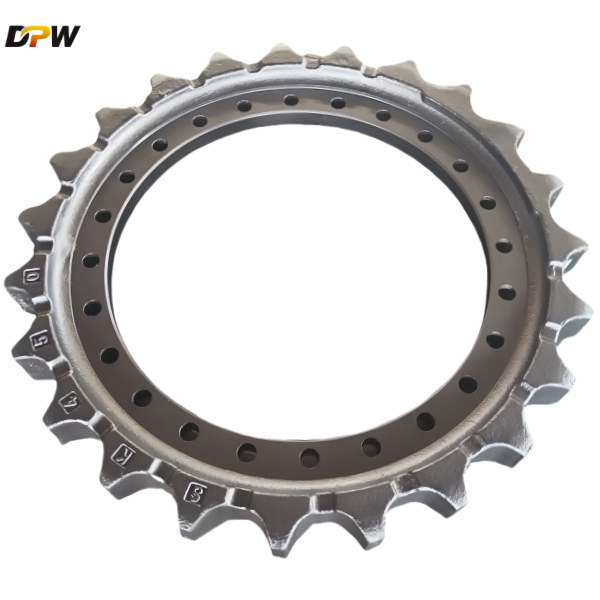
| |||||||||||||||||||||||||||||||||||||||||||||||||||||||||||||||||||||||||||||||||||||||||||||||||||||||||||||||||||||||||||||||||||||||||||||||||||||||||||||||||||||||||||||||||||||||||||||||||||||||||||||||||||||||||||||||||||||||||||||||||||||||||||||||||||||||||||||||||||||||||||||||||||||||||||||||||||||||||||||||||||||||||||||||||||||||||||||||||||||||||||||||||||||||||||||||||||||||||||||||||||||||||||||||||||||||||||||||||||||||||||||||||||||||||||||||||||||||||||||
